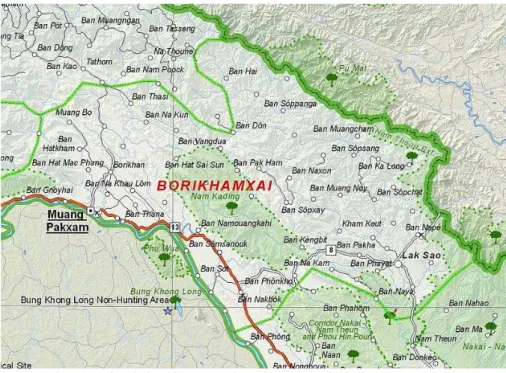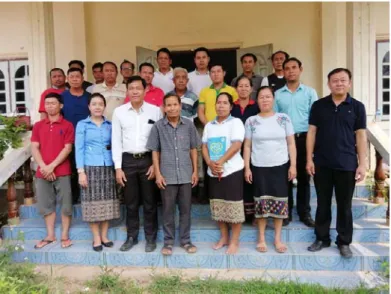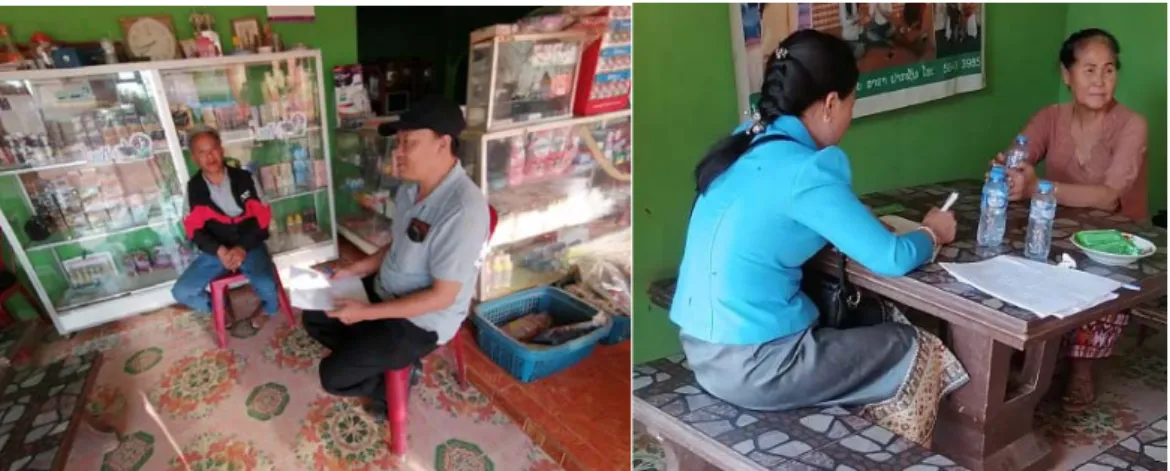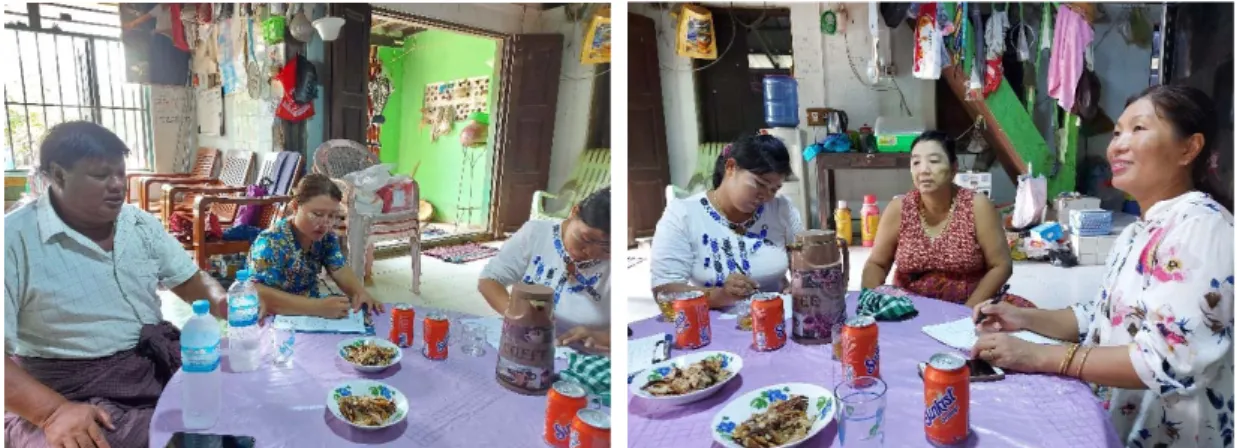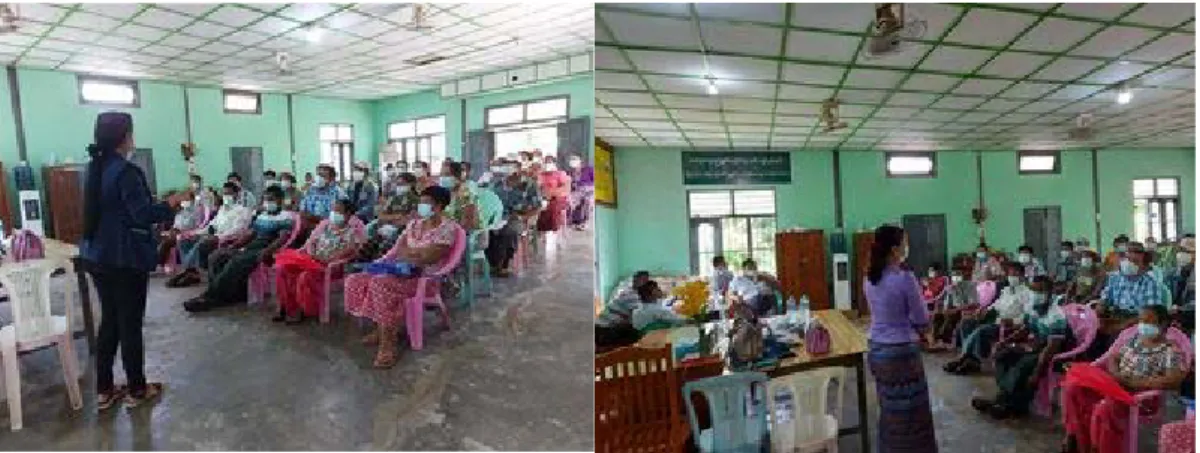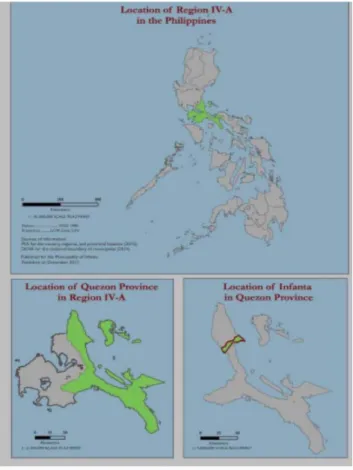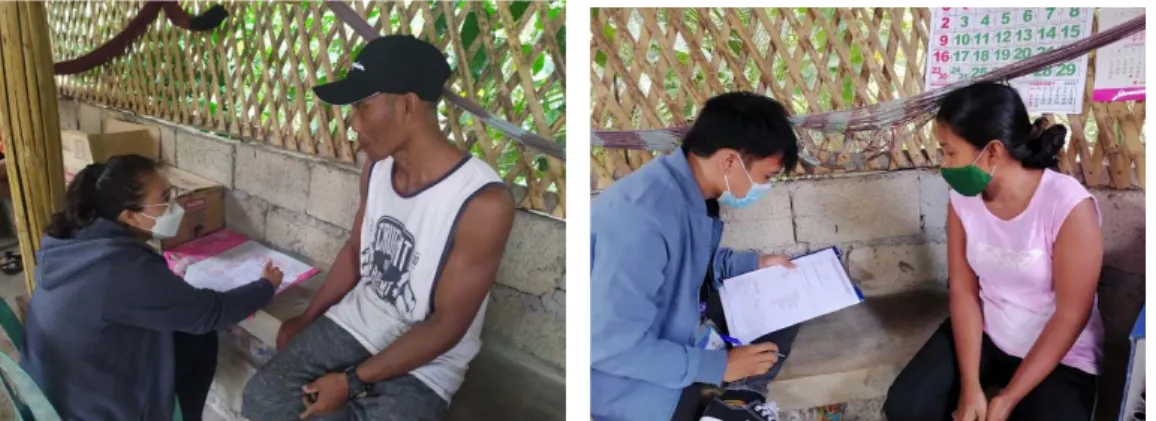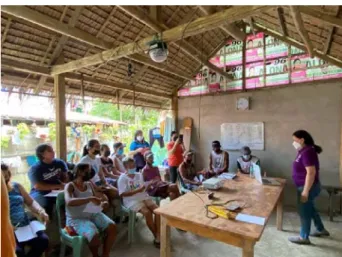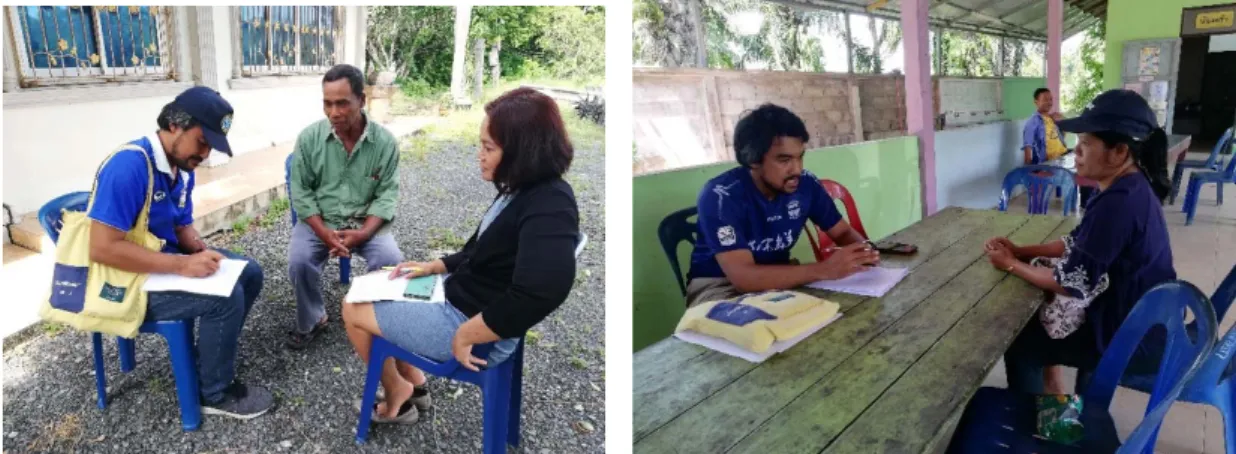The Gender Dimension of Small-Scale Fisheries and Aquaculture Value Chains in Southeast Asia. Semi-structured interviews were conducted to determine the gender dimension of the small-scale fisheries and aquaculture value chain in Southeast Asia. Data collection on the gender dimension of the small-scale inland aquaculture value chain in Pakxan District, Bolikhamxay Province, Lao PDR (January 25-29, 2021).
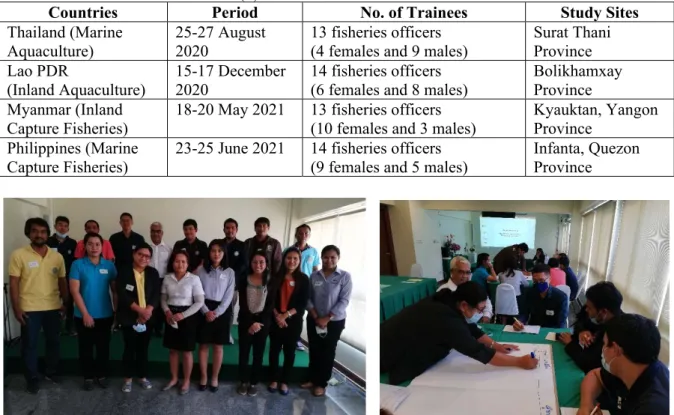
Myanmar
As in the study process, the activity also included the Data Validation Workshop on 29 June 2021 (Figure 10) with 54 participants (16 women and 38 men). Data collection on gender dimension in the value chain of small-scale inland fisheries in Kyauktan, Yangon Region, Myanmar (24-28 May 2021).
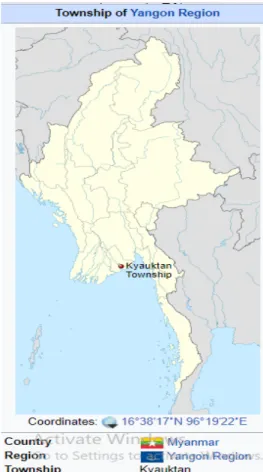
Philippines
Philippine Bureau of Fisheries and Aquatic Resources (BFAR) enumerators utilized the questionnaire (Appendix 3) developed during the training to collect data on the gender dimension in the value chain of small-scale marine fisheries in Infanta, Quezon Province, Philippines. The impact of the COVID-19 pandemic had led to delays in data collection processes in the Philippines. Data Collection on Gender Dimension in Small Scale Marine Fisheries Value Chain in Infanta, Quezon Province, Philippines (November 16-19, 2021).
Thailand
The SEAFDEC team and fisheries officers from the Department of Fisheries of Thailand conducted the data collection on gender study using the questionnaire (Appendix 4) developed during the training to collect the data Gender Dimension in the Value Chain of Collecting Small-scale Marine Aquaculture on 28-30 August 2020. Data collection on gender dimension in the value chain of small-scale marine aquaculture Surat Thani, Thailand (28-30 August 2020). Results of the study on gender dimension in the value chain of small-scale fisheries and aquaculture in Southeast Asia Fisheries and aquaculture in Southeast Asia.
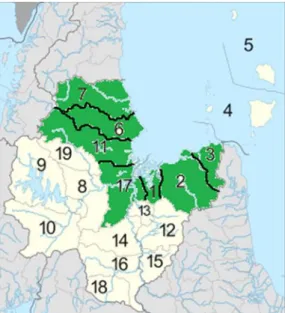
Results of the Study on Gender Dimension in the Value Chain of Small-scale Fisheries and Aquaculture in Southeast Asia Fisheries and Aquaculture in Southeast Asia
Gender Dimension in the Value Chain of Small-scale Inland Aquaculture in Pakxan District, Bolikhamxay Province, Lao PDR
- General information 1) Demographic information
Occupation
Small-scale Inland Aquaculture
Regarding the care of children, it seems that this is one of the main roles of women in the family (52 %) although both men and women also take care of the children (48 %), especially when the men are at home. fishing or in between while doing house maintenance, but this is not done by men alone. While cooking is mainly the role of women (64%), it can also be performed by men and women (36%), especially when the men are not fishing. Growing vegetables in home gardens is mainly a role for women (50 %) as they are mostly at home while men fish most of the time, but in some cases this role is fulfilled by both men and women (46 %), especially when the men are not fishing.
Productive roles
In raising livestock for consumption, both men and women are more involved (73 %), men (19 %) and women (8 %) because the men have to build the cattle pens while the women help with the maintenance and rearing of the animals, like feeding the livestock. In terms of participation in social gatherings, the involvement of both men and women is high (79 %), indicating high interest of both men and women in discussions about their community, while that of men alone is 14 % as they are most of the fishing fishing. time, and women only 7 % as they represent the men who could not attend the meetings. Nevertheless, as could be observed from Figure 18, the male respondents indicated that they do not perform household tasks, even if the main respondents of the survey are men.
Access and Control Over Resources
Gender perspectives
In Pakxan District, Bolikhamxay Province, farmers have formed into groups, such as Pakpuang Group, Fish Cage Group and Pakxan Group. As we take a look at these groups, there seems to be a disparity between women and men in participating group meetings. Men gave better answers to questions and men are working hard (1) - Aquaculture as a male job (1).
Close monitoring of the health of people in the community, occasionally (1) - Help promote health education of the elderly and treatment (1) - Encourage a career path in the community (1). As mentioned above, the role of men and women in Pakxan District, Bolikhamxay Province, Lao PDR is physically divided by gender. The daily chores of women in Pakxan District, Bolikhamxay Province, Lao People's Republic are busy and busy to the extent that women do not have time to attend village meetings.
Moreover, women also do not participate much in the aquaculture activities as men are known to be skilled in aquaculture activities while the women are engaged in household chores. Since the main problem in Pakxan district, Bolikhamxay province is the unstable price of the products, fish processing should be promoted to preserve the products and wait for the right and fair price, while providing jobs for women who usually take care of fish processing and post-harvest. As fish farmers are faced with fish disease problems, training in farming techniques and animal health management should be provided, ensuring a balanced participation of women and men in order to enhance the knowledge and skills of women and men in fish farming techniques and produce high-quality products. products that command good prices.
To reduce the strong stereotype of women having to do mainly housework, awareness on gender concepts should be promoted in the country at all levels, especially in local communities.
Gender Dimension in the Value Chain of Small-scale Inland Fisheries in Kyauktan, Yangon Region, Myanmar
- General information 1) Demographic information
Inland fishing in Kyauktan, Yangon Region, Myanmar
The productive roles in this case are those related to fishing in the inland waters of Kyauktan. Meanwhile, the women help the men maintain the fishing equipment and nets and repair the fishing equipment when necessary. The roles of men and women in post-fishery inland waters, Kyauktan, Yangon Region, Myanmar.
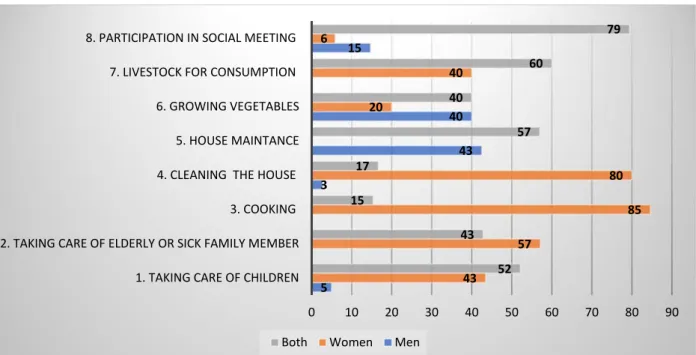
Access, ownership and control over resources
Conclusion and recommendations for intervention
For the gender roles in fisheries, men work to prepare and organize the fishing operations, but women are also involved in some tasks such as preparing the fishing nets and selling fish mostly to the middlemen in the village. While women mainly do household work (such as child care, elderly care, cooking, cleaning and ensuring food security), the men do the work for fishing, including making decisions about fishing matters because they are primarily responsible for the fishing operations. On the other hand, most of the men do laborious tasks like home repair and maintenance.
However, decision-making in the household is done by the women and men who always consult each other. The survey also found that the women have the same chance as the men to attend community activities. Furthermore, the survey also found that men and women make decisions together for important activities.
Recommendation for intervention in inland fisheries in Kyauktan, Yangon Region, Myanmar focuses on improving the livelihoods of women and men. For the problem of diminishing fisheries resources, raising awareness among women, men and youth about the sustainable use and improvement of resources through training or study trips or other media campaigns. To support women in their livelihoods with fish farming (drying fish) for income generation and for maintaining grocery stores for ease of purchasing goods, a cooperative group should be established for the collection of fish products. dried and selling other goods to local residents.
Regarding the need for access to low-interest loans, a cooperative or microfinance system should be established to support low-interest loans to group members in Kyauktan.
Gender Dimension in the Value Chain of Small-scale Marine Capture Fisheries in Infanta, Quezon Province, Philippines
- General information 1) Demographic information
Small-scale Marine Fisheries in Infanta, Quezon Province, Philippines
In Infanta, Quezon Province, women mainly work as cleaners, as can be seen in Figure 24, where the women take care of laundry (69%) and dishes (50%) and clean the house (59%). Women and men work together in childcare (50%), as well as caring for elderly or sick family members (50%), cooking (44%) and participating in social activities (52%). However, the women also participate in most of the activities, especially in fish processing, fish sales, ship trading for better prices for fish, as well as preparing boats and tools.
Both men and women can access, own and control resources and services with high percentages as shown in Table 11. Women have the power to make decisions in choosing buyers or clients and harvesting products (47% ). However, women have little access to capacity building for such training and to participate in study visits.
Given that most men are members of fishing groups, they are dominant in fishing activities and are therefore more involved in group meetings than women (40% women and 60% men). However, participation in group meetings can be fairly balanced, because when the men are busy at sea, the women can represent the men in those meetings. The main recommendations raised by respondents for their livelihood development include access to capital for fishing (40%) and employment opportunities (40%).
Only a small percentage of respondents mentioned health (10%) and education (10%) community development.
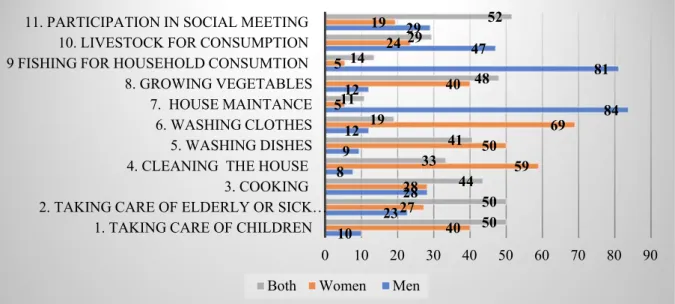
Conclusion and recommendations for the intervention
Gender Dimension in the Value Chain of Small-scale Marine aquaculture Surat Thani, Thailand
- General information
- Gender Dimension 1) Reproductive roles
- Conclusion and recommendations for the intervention
In relation to men's and women's reproductive roles (Figure 27), men mainly perform housekeeping, fishing and raising livestock for domestic consumption. However, men and women perform some reproductive tasks together such as growing vegetables and participating in community events. Regarding the productive roles of men and women, Figure 28 shows that men perform most of the tasks in aquaculture, while men and women share the burden when it comes to calculating expenses and income.
Women and men have equal access to household assets such as houses, farmland, cars and motorcycles, yet men are dominant in ownership and control over those assets. Bank credit is given by men and may be linked to ownership and control of household assets which are predominantly men. Money lending is mostly accessed, owned and controlled by women, while life/health insurance, car insurance, public health can be accessed by both women and men, but car ownership and control is by men and this is important due to the fact that men are the main owners of family cars.
In addition, the gender roles in the household showed that women still do the domestic work such as cooking, looking after children and the elderly and gardening in the backyard, while men do the arduous tasks such as house repair. Although men may have their main roles in aquaculture and women's main role is in the household, both men and women could help together in the household work as well as in the aquaculture operation. Moreover, the results of the study also showed that men and women make decisions together about important activities.
The study therefore suggests that men and women should have more understanding of the gender roles that can change their attitude about work, that is to assist each other in the household works, because in terms of working time spent, women have more workload than men.
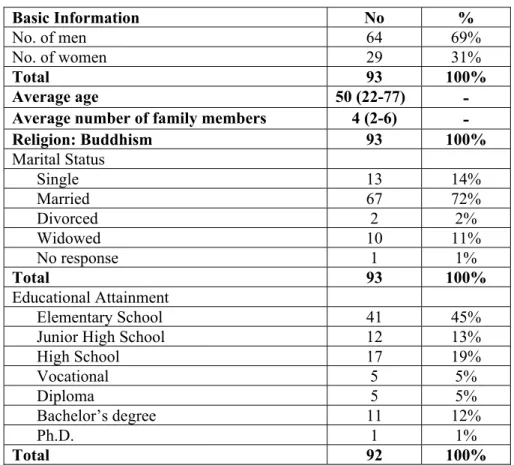
Conclusions
Creating job opportunities such as homestays and organizing women's groups in the community to strengthen women's influence in income generation.
